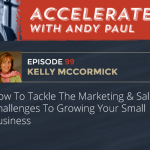 Hi, I’m Kelly McCormick, a Business Growth and Marketing Strategist. I help entrepreneurs & companies to identify opportunities for growth. Plus, I develop targeted branding, marketing & sales strategies. I can help you too!
Hi, I’m Kelly McCormick, a Business Growth and Marketing Strategist. I help entrepreneurs & companies to identify opportunities for growth. Plus, I develop targeted branding, marketing & sales strategies. I can help you too! Kelly McCormick's Business Tips
Recent Posts
Why a Single Email Could Cost You $16,000!
(Guest Post by Brian Cuda – Conceptinet)

Would you pay $16,000 to send a single email? My guess is that such expenditure is not in your marketing budget to potentially gain just a single customer.
But you may be risking penalties of that caliber or more, per email, if your transmissions do not comply with the CAN-SPAM Act (United States)….
Controlling the Assault of Non-Solicited Pornography And Marketing Act of 2003 (CAN-SPAM) was signed into law in 2003, and amended for clarification in 2008.
The act establishes a federal standard for commercial email communication. It is designed to protect the consumer from email abuse and provide a way for consumers to stop unwanted emails. Companies and consumers also call this “opt-out.”
How can you avoid fines?
Clients often ask me how to avoid email SPAM violations. The answer is simple: Follow the rules.
Email newsletters and mailing lists can be a very effective and inexpensive form of marketing for some industries. The CAN-SPAM law, however, applies to all commercial email, even small businesses.
It’s a good idea to review the Federal Trade Commission’s Compliance Guide for Business at http://business.ftc.gov/documents/bus61-can-spam-act-compliance-guide-business, and consult your attorney before sending email newsletters or marketing to your mailing list.
Other consequences to non-compliance:
You may have already encountered some of CAN-SPAM’s limitations if you use an email newsletter program.
Some of the more reputable newsletter systems, such as Constant Contact, help you comply by asking you how you obtained your email list, adding opt-out links to your messages, and requiring a physical address in the message footer. If you do not comply with the rules, some systems will terminate your account.
Another limitation may come from your email provider, which may limit the amount of outgoing mail you can send in a day.
They have an interest in ensuring they avoid hosting “spammy” accounts, which puts their email server at risk for blacklisting.
What does this mean to the small-business owner?
Small-business owners who do not have a budget for government fines must work toward compliance and ensure that everyone to whom they are sending mail wants to receive that communication.
Keep in mind that your message, announcement, special offers, or coupons may be interesting, but not everyone wants to hear about them via email. Develop alternative communication channels.
Again, following the rules will generally keep you out of trouble.
Before you send your next email newsletter or advertisement, ask yourself if you want or need more messages in your own inbox.
If the answer is “No,” the Golden Rule may be the only guideline you need. If your answer is “Yes,” please send me your email address.
About Brian Cuda: Brian Cuda is co-founder of Conceptinet, a website design, development, hosting, social media and marketing firm located in Santa Clarita, California. Brian can be reached at 661-338-0830 or www.conceptinet.com. (This article originally appeared in Santa Clarita Valley Signal)
(Guest Post by Brian Cuda – Conceptinet)
 Hi, I’m Kelly McCormick, a Business Growth and Marketing Strategist. I help entrepreneurs & companies to identify opportunities for growth. Plus, I develop targeted branding, marketing & sales strategies. I can help you too!
Hi, I’m Kelly McCormick, a Business Growth and Marketing Strategist. I help entrepreneurs & companies to identify opportunities for growth. Plus, I develop targeted branding, marketing & sales strategies. I can help you too! 





 Connect Through Social Media
Connect Through Social Media 



